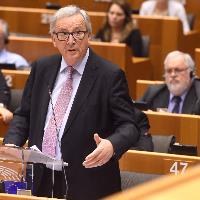(BRUSSELS) – President of the EU Commission Jean-Claude Juncker presented a White Paper to the European Parliament Wednesday outlining five possible paths for the EU to take in the coming years post-Brexit.
The five scenarios included “carrying on”, “nothing but the single market”, “those who want more do more”, “doing less more efficiently”, and “doing much more together”.
“Our task today is to show what Europe can and cannot do”, Mr Juncker said, pointing out for example that “Europe alone cannot be held responsible for fighting unemployment”.
With the EU preparing later this month to mark the 60th Anniversary of the Treaties of Rome, Mr Juncker said that Brexit “however regrettable and painful it may be” will not be able to stop the EU on its march towards its future. What future was now the question. “There is no better time, there is also no other time, than now to have this admittedly difficult debate,” he said.
The White Paper looks at the changes Europe can expect over the next decade, from the impact of new technologies on society and jobs, to doubts about globalisation, security concerns and the rise of populism.
The choices the EU faces, said Mr Juncker are “being swept along by those trends, or embracing them and seizing the new opportunities they bring. Europe’s population and economic weight is falling as other parts of the world grow.”
The White Paper’s five scenarios offer a glimpse into the potential state of the Union by 2025 depending on the choices Europe will make.
Scenario 1: Carrying On – The EU27 focuses on delivering a positive reform agenda along the lines of the Commission’s New Start for Europe and the Bratislava Declaration which, by 2025, could mean: Europeans can drive automated and connected cars but can encounter problems when crossing borders as some legal and technical obstacles persist. Europeans mostly travel across borders without having to stop for checks. Reinforced security controls mean having to arrive at airports and train stations well in advance of departure.
Scenario 2: Nothing but the Single Market The EU27 is gradually re-centred on the single market as the 27 Member States are not able to find common ground on an increasing number of policy areas. By 2025 this could mean: Crossing borders for business or tourism becomes difficult due to regular checks. Finding a job abroad is harder and the transfer of pension rights to another country not guaranteed. Those falling ill abroad face expensive medical bills. Europeans are reluctant to use connected cars due to the absence of EU-wide rules and technical standards.
Scenario 3: Those Who Want More Do More The EU27 proceeds as today but allows willing Member States to do more together in specific areas such as defence, internal security or social matters. One or several “coalitions of the willing” emerge. By 2025 this could mean that: 15 Member States set up a police and magistrates corps to tackle cross-border criminal activities. Security information is immediately exchanged as national databases are fully interconnected. Connected cars are used widely in 12 Member States which have agreed to harmonise their liability rules and technical standards.
Scenario 4: Doing Less More Efficiently – The EU27 focuses on delivering more and faster in selected policy areas, while doing less where it is perceived not to have an added value. Attention and limited resources are focused on selected policy areas. By 2025 this could mean A European Telecoms Authority will have the power to free up frequencies for cross-border communication services, such as the ones used by connected cars. It will also protect the rights of mobile and Internet users wherever they are in the EU. A new European Counter-terrorism Agency helps to deter and prevent serious attacks through a systematic tracking and flagging of suspects.
Scenario 5: Doing Much More Together Member States decide to share more power, resources and decision-making across the board. Decisions are agreed faster at European level and rapidly enforced. By 2025 this could mean: Europeans who want to complain about a proposed EU-funded wind turbine project in their local area cannot reach the responsible authority as they are told to contact the competent European authorities. Connected cars drive seamlessly across Europe as clear EU-wide rules exist. Drivers can rely on an EU agency to enforce the rules.
The White Paper is the European’s Commission contribution to the Rome Summit, the moment when the EU will discuss its achievements of the past 60 years but also its future at 27.



